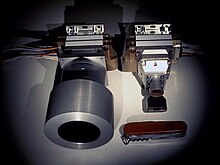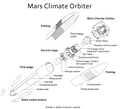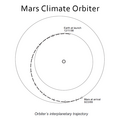cosmos.wikisort.org - Spacecraft
The Mars Climate Orbiter (formerly the Mars Surveyor '98 Orbiter) was a 638-kilogram (1407 lb)[1] robotic space probe launched by NASA on December 11, 1998, to study the Martian climate, Martian atmosphere, and surface changes and to act as the communications relay in the Mars Surveyor '98 program for Mars Polar Lander. However, on September 23, 1999, communication with the spacecraft was permanently lost as it went into orbital insertion. The spacecraft encountered Mars on a trajectory that brought it too close to the planet, and it was either destroyed in the atmosphere or escaped the planet's vicinity and entered an orbit around the Sun.[2] An investigation attributed the failure to a measurement mismatch between two software systems: metric units by NASA and US customary units by spacecraft builder Lockheed Martin.[3]
 Artist's conception of the Mars Climate Orbiter | |
| Mission type | Mars orbiter |
|---|---|
| Operator | NASA / JPL |
| COSPAR ID | 1998-073A |
| SATCAT no. | 25571 |
| Website | mars |
| Mission duration | 286 days Mission failure |
| Spacecraft properties | |
| Manufacturer | Lockheed Martin |
| Launch mass | 638 kilograms (1407 lb)[1] |
| Power | 500 watts |
| Start of mission | |
| Launch date | December 11, 1998, 18:45:51 UTC |
| Rocket | Delta II 7425 |
| Launch site | Cape Canaveral SLC-17A |
| End of mission | |
| Last contact | 23 September 1999 09:06:00 UTC |
| Decay date | September 23, 1999 Unintentionally deorbited |
| Orbital parameters | |
| Reference system | Areocentric |
| Epoch | Planned |
Mission background
History
After the loss of Mars Observer and the onset of the rising costs associated with the future International Space Station, NASA began seeking less expensive, smaller probes for scientific interplanetary missions. In 1994, the Panel on Small Spacecraft Technology was established to set guidelines for future miniature spacecraft. The panel determined that the new line of miniature spacecraft should be under 1000 kg (2200 pounds) with highly focused instrumentation.[4] In 1995, a new Mars Surveyor program began as a set of missions designed with limited objectives, low costs, and frequent launches. The first mission in the new program was Mars Global Surveyor, launched in 1996 to map Mars and provide geologic data using instruments intended for Mars Observer.[5] Following Mars Global Surveyor, Mars Climate Orbiter carried two instruments, one originally intended for Mars Observer, to study the climate and weather of Mars.
The primary science objectives of the mission included:[6]
- determine the distribution of water on Mars
- monitor the daily weather and atmospheric conditions
- record changes on the Martian surface due to wind and other atmospheric effects
- determine temperature profiles of the atmosphere
- monitor the water vapor and dust content of the atmosphere
- look for evidence of past climate change.
Spacecraft design
The Mars Climate Orbiter bus measured 2.1 meters (6 feet 11 inches) tall, 1.6 meters (5 feet 3 inches) wide and 2 meters (6 feet 7 inches) deep. The internal structure was largely constructed with graphite composite/aluminum honeycomb supports, a design found in many commercial airplanes. With the exception of the scientific instruments, battery and main engine, the spacecraft included dual redundancy on the most important systems.[6][7]
The spacecraft was 3-axis stabilized and included eight hydrazine monopropellant thrusters: four 22 N (4.9 lbf) thrusters to perform trajectory corrections and four 0.9 N (3.2 ozf) thrusters to control attitude. Orientation of the spacecraft was determined by a star tracker, two sun sensors and two inertial measurement units. Orientation was controlled by firing the thrusters or using three reaction wheels. To perform the Mars orbital insertion maneuver, the spacecraft also included a LEROS 1B main engine rocket,[8] providing 640 N (140 lbf) of thrust by burning hydrazine fuel with nitrogen tetroxide (NTO) oxidizer.[6][7]
The spacecraft included a 1.3-meter (4-foot-3-inch) high-gain antenna to transceive data with the Deep Space Network over the x band. The radio transponder designed for the Cassini–Huygens mission was used as a cost-saving measure. It also included a two-way UHF radio frequency system to relay communications with Mars Polar Lander upon an expected landing on December 3, 1999.[6][7][9]
The space probe was powered with a 3-panel solar array, providing an average of 500 W (0.67 hp) at Mars. Deployed, the solar array measured 5.5 meters (18 ft 1 in) in length. Power was stored in 12-cell, 16-amp-hour Nickel hydrogen batteries. The batteries were intended to be recharged when the solar array received sunlight and power the spacecraft as it passed into the shadow of Mars. When entering into orbit around Mars, the solar array was to be utilized in the aerobraking maneuver, to slow the spacecraft until a circular orbit was achieved. The design was largely adapted from guidelines from the Small Spacecraft Technology Initiative outlined in the book, Technology for Small Spacecraft.[6][7][10]
In an effort to simplify previous implementations of computers on spacecraft, Mars Climate Orbiter featured a single computer using an IBM RAD6000 processor utilizing a POWER1 ISA capable of 5, 10 or 20 MHz operation. Data storage was to be maintained on 128 MB of random-access memory (RAM) and 18 MB of flash memory. The flash memory was intended to be used for highly important data, including triplicate copies of the flight system software.[6]
Scientific instruments



The Pressure Modulated Infrared Radiometer (PMIRR) uses narrow-band radiometric channels and two pressure modulation cells to measure atmospheric and surface emissions in the thermal infrared and a visible channel to measure dust particles and condensates in the atmosphere and on the surface at varying longitudes and seasons.[11] Its principal investigator was Daniel McCleese at JPL/CALTECH. Similar objectives were later achieved with Mars Climate Sounder on board Mars Reconnaissance Orbiter. Its objectives:[12]
- Map the three-dimensional and time-varying thermal structure of the atmosphere from the surface to 80 km altitude.
- Map the atmospheric dust loading and its global, vertical and temporal variation.
- Map the seasonal and spatial variation of the vertical distribution of atmospheric water vapor to an altitude of at least 35 km.
- Distinguish between atmospheric condensates and map their spatial and temporal variation.
- Map the seasonal and spatial variability of atmospheric pressure.
- Monitor the polar radiation balance.
The Mars Color Imager (MARCI) is a two-camera (medium-angle/wide-angle) imaging system designed to obtain pictures of the Martian surface and atmosphere. Under proper conditions, resolutions up to 1 kilometer (3300 ft) are possible.[13][14] The principal investigator on this project was Michael Malin at Malin Space Science Systems and the project was reincorporated on Mars Reconnaissance Orbiter. Its objectives:[13]
- Observe Martian atmospheric processes at global scale and synoptically.
- Study details of the interaction of the atmosphere with the surface at a variety of scales in both space and time.
- Examine surface features characteristic of the evolution of the Martian climate over time.
| Filter name |
Camera angle |
Wavelength | |
|---|---|---|---|
| (nm) | Color | ||
| UV1 | Wide | 280 | Invisible |
| UV2 | Wide | 315 | Invisible |
| MA1 | Medium | 445 | |
| WA1 | Wide | 453 | |
| MA2 | Medium | 501 | |
| WA2 | Wide | 561 | |
| MA3 | Medium | 562 | |
| WA3 | Wide | 614 | |
| WA4 | Wide | 636 | |
| MA4 | Medium | 639 | |
| WA5 | Wide | 765 | |
| MA5 | Medium | 767 | |
| MA6 | Medium | 829 | Slightly visible |
| MA7 | Medium | 903 | Invisible |
| MA8 | Medium | 1002 | Invisible |
Mission profile
| Date | Time (UTC) | Event |
|---|---|---|
| Dec 11 1998 | 18:45:51 | Spacecraft launched |
| Sep 23 1999 | 08:41:00 | Insertion begins. Orbiter stows solar array. |
| 08:50:00 | Orbiter turns to correct orientation to begin main engine burn. | |
| 08:56:00 | Orbiter fires pyrotechnic devices which open valves to begin pressurizing the fuel and oxidizer tanks. | |
| 09:00:46 | Main engine burn starts; expected to fire for 16 minutes 23 seconds. | |
| 09:04:52 | Communication with spacecraft lost | |
| 09:06:00 | Orbiter expected to enter Mars occultation, out of radio contact with Earth.[n 1] | |
| 09:27:00 | Expected to exit Mars occultation.[n 1] | |
| Sep 25 1999 | Mission declared a loss. Reason for loss known. No further attempts to contact. |
Launch and trajectory
The Mars Climate Orbiter probe was launched on December 11, 1998, at 18:45:51 UTC by the National Aeronautics and Space Administration from Space Launch Complex 17A at the Cape Canaveral Space Force Station in Florida, aboard a Delta II 7425 launch vehicle. The complete burn sequence lasted 42 minutes bringing the spacecraft into a Hohmann transfer orbit, sending the probe into a 9.5 months, 669 million km (416 million mi) trajectory.[6][9] At launch, Mars Climate Orbiter weighed 638 kg (1407 lb) including propellant.[1]
 Exploded diagram of Delta II launch vehicle with Mars Climate Orbiter
Exploded diagram of Delta II launch vehicle with Mars Climate Orbiter- Launch of Mars Climate Orbiter by NASA on a Delta II 7425 launch vehicle
 Interplanetary trajectory of Mars Climate Orbiter
Interplanetary trajectory of Mars Climate Orbiter Aerobraking procedure to place Mars Climate Orbiter into orbit around Mars
Aerobraking procedure to place Mars Climate Orbiter into orbit around Mars
Encounter with Mars
- This image of Mars on September 7, 1999, is the only image acquired by the Orbiter.
 Diagram comparing the intended and actual trajectories of the Orbiter
Diagram comparing the intended and actual trajectories of the Orbiter
Mars Climate Orbiter began the planned orbital insertion maneuver on September 23, 1999, at 09:00:46 UTC. Mars Climate Orbiter went out of radio contact when the spacecraft passed behind Mars at 09:04:52 UTC, 49 seconds earlier than expected, and communication was never reestablished. Due to complications arising from human error, the spacecraft encountered Mars at a lower-than-anticipated altitude and it was either destroyed in the atmosphere or re-entered heliocentric space after leaving Mars' atmosphere.[2] Mars Reconnaissance Orbiter has since completed most of the intended objectives for this mission.
Cause of failure
The problem here was not the error; it was the failure of NASA's systems engineering, and the checks and balances in our processes, to detect the error. That's why we lost the spacecraft.
—Edward Weiler, NASA associate administrator for space science, IEEE Spectrum: Why the Mars Probe went off course
On November 10, 1999, the Mars Climate Orbiter Mishap Investigation Board released a Phase I report, detailing the suspected issues encountered with the loss of the spacecraft.
Previously, on September 8, 1999, Trajectory Correction Maneuver-4 (TCM-4) was computed, and was then executed on September 15, 1999. It was intended to place the spacecraft at an optimal position for an orbital insertion maneuver that would bring the spacecraft around Mars at an altitude of 226 km (140 miles) on September 23, 1999.
However, during the week between TCM-4 and the orbital insertion maneuver, the navigation team reported that it appeared the insertion altitude could be much lower than planned, at about 150 to 170 km (93 to 106 miles). Twenty-four hours prior to orbital insertion, calculations placed the orbiter at an altitude of 110 km (68 miles). 80 km (50 miles) was the minimum altitude that Mars Climate Orbiter was thought to be capable of surviving during this maneuver.
During insertion, the orbiter was intended to skim through Mars' upper atmosphere, gradually aerobraking for weeks, but post-failure calculations showed that the spacecraft's trajectory would have taken it within 57 km (35 miles) of the surface. At this altitude, the spacecraft would likely have skipped violently off the denser-than-expected atmosphere,[citation needed] and it was either destroyed in the atmosphere, or re-entered heliocentric space.[2]
The primary cause of this discrepancy was that one piece of ground software supplied by Lockheed Martin produced results in a United States customary unit, contrary to its Software Interface Specification (SIS), while a second system, supplied by NASA, expected those results to be in SI units, in accordance with the SIS. Specifically, software that calculated the total impulse produced by thruster firings produced results in pound-force seconds. The trajectory calculation software then used these results – expected to be in newton-seconds (incorrect by a factor of 4.45)[15] – to update the predicted position of the spacecraft.[16]
Still, NASA does not place the responsibility on Lockheed for the mission loss; instead, various officials at NASA have stated that NASA itself was at fault for failing to make the appropriate checks and tests that would have caught the discrepancy.[17]
The discrepancy between calculated and measured position, resulting in the discrepancy between desired and actual orbit insertion altitude, had been noticed earlier by at least two navigators, whose concerns were dismissed because they "did not follow the rules about filling out [the] form to document their concerns". A meeting of trajectory software engineers, trajectory software operators (navigators), propulsion engineers, and managers was convened to consider the possibility of executing Trajectory Correction Maneuver-5, which was in the schedule. Attendees of the meeting recall an agreement to conduct TCM-5, but it was ultimately not done.[17]
Project costs
According to NASA, the cost of the mission was $327.6 million ($494.84 million in 2020)[18] total for the orbiter and lander, comprising $193.1 million ($291.68 million in 2020)[18] for spacecraft development, $91.7 million ($138.51 million in 2020)[18] for launching it, and $42.8 million ($64.65 million in 2020)[18] for mission operations.[19]
See also
- List of missions to Mars
- List of artificial objects on Mars
- List of software bugs
- Metrication
Notes
- Planned but unaccounted for event.
References
- "1998 MARS CLIMATE ORBITER ARRIVES AT NASA'S KENNEDY SPACE CENTER FOR FINAL LAUNCH PREPARATIONS" (Press release). NASA MEDIA RELATIONS OFFICE. September 14, 1998. Archived from the original on October 8, 1999. Retrieved January 3, 2011.
- Stephenson, Arthur G.; LaPiana, Lia S.; Mulville, Daniel R.; Rutledge, Peter J.; Bauer, Frank H.; Folta, David; Dukeman, Greg A.; Sackheim, Robert; Norvig, Peter (November 10, 1999). Mars Climate Orbiter Mishap Investigation Board Phase I Report (PDF). NASA.
- "Metric mishap caused loss of NASA orbiter". CNN. September 30, 1999. Retrieved March 21, 2016.
- Panel on Small Spacecraft Technology, National Research Council (1994). Technology for Small Spacecraft. Washington D.C.: National Academy Press. ISBN 0-309-05075-8. Retrieved January 13, 2011.
- Committee on Planetary and Lunar Exploration, Commission on Physical Sciences, Mathematics, and Applications, National Research Council (1995). The Role of Small Missions in Planetary and Lunar Exploration. Washington D.C.: National Academies Press. doi:10.17226/12285. hdl:2060/19960002222. ISBN 978-0-309-12250-4. S2CID 219866579. Retrieved January 13, 2011.
- "Mars Climate Orbiter Arrival Press Kit" (PDF) (Press release). NASA / JPL. September 1999. Retrieved January 13, 2011.
- "Mars Climate Orbiter Flight System Description". NASA / JPL. 1998. Retrieved January 13, 2011.
- LEROS 1B Archived September 3, 2011, at the Wayback Machine
- "1998 Mars Missions Press Kit" (PDF) (Press release). NASA / JPL. December 1998. Retrieved January 13, 2011.
- Panel on Small Spacecraft Technology, National Research Council (1994). Technology for Small Spacecraft. Washington D.C.: National Academy Press. pp. 121–123. ISBN 0-309-05075-8. Retrieved January 13, 2011.
- "Pressure Modulated Infrared Radiometer (PMIRR)". NASA / National Space Science Data Center. Retrieved February 19, 2011.
- Albee, Arden L. (1988). "Workshop on Mars Sample Return Science". Mars Sample Return Science. Lunar and Planetary Inst.: 25–29. Bibcode:1988msrs.work...25A.
- Malin, M.C.; Bell (III), J.F.; Calvin, W.M.; Caplinger, M.A.; Clancy, R.T.; Harberle, R.M.; James, P.B.; Lee, S.W.; Ravine, M.A.; Thomas, P.; Wolff, M.J. (2001). "Mars Color Imager (MARCI) on the Mars Climate Orbiter" (PDF). Journal of Geophysical Research. 106 (E8): 17, 651–17, 672. Bibcode:2001JGR...10617651M. doi:10.1029/1999JE001145. Retrieved January 13, 2011.
- "Mars Color Imager (MARCI)". NASA / National Space Science Data Center. Retrieved February 19, 2011.
- Mars Climate Orbiter Mishap Investigation Board Phase I Report, pg 13
- "Mars Climate Orbiter Mishap Investigation Board Phase I Report" (PDF) (Press release). NASA. November 10, 1999. Archived from the original (PDF) on September 20, 2001. Retrieved May 11, 2021.
- Oberg, James (December 1, 1999). "Why the Mars Probe went off course". IEEE Spectrum. IEEE. Retrieved July 13, 2016.
- Johnston, Louis; Williamson, Samuel H. (2022). "What Was the U.S. GDP Then?". MeasuringWorth. Retrieved February 12, 2022. United States Gross Domestic Product deflator figures follow the Measuring Worth series.
- "Mars Climate Orbiter Fact Sheet". mars.nasa.gov. NASA-JPL. Archived from the original on October 3, 2012. Retrieved August 3, 2020.
External links
- Mars Surveyor '98 launch press kit
- Mars Climate Orbiter arrival at Mars press kit
- Mars Climate Orbiter Mission Profile by NASA's Solar System Exploration
- NASA Space Science Data Coordinated Archive
- Mars Climate Orbiter Mishap Investigation Board Phase I Report - November 10, 1999
На других языках
[de] Mars Climate Orbiter
Mars Climate Orbiter (MCO) war eine NASA-Sonde zum Mars im Rahmen des Discovery-Programms. Sie ging 1999 aufgrund eines Einheitenfehlers im Navigationssystem verloren.[1]- [en] Mars Climate Orbiter
[ru] Mars Climate Orbiter
Mars Climate Orbiter — неудачная миссия НАСА по исследованию марсианского климата, часть программы Mars Surveyor 98. MCO создавался как спутник-транслятор для посадочного аппарата Mars Polar Lander, а после прекращения функционирования последнего, должен был заняться изучением марсианского климата.Другой контент может иметь иную лицензию. Перед использованием материалов сайта WikiSort.org внимательно изучите правила лицензирования конкретных элементов наполнения сайта.
WikiSort.org - проект по пересортировке и дополнению контента Википедии












